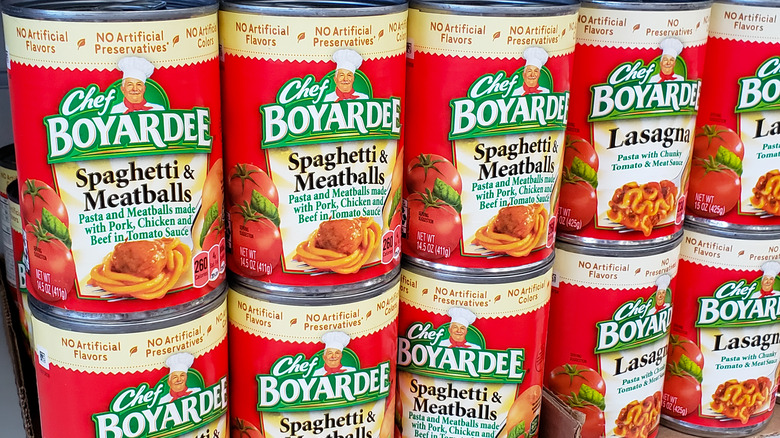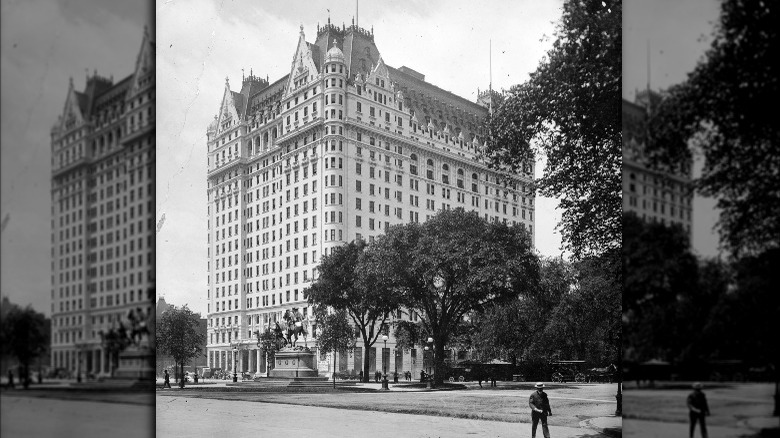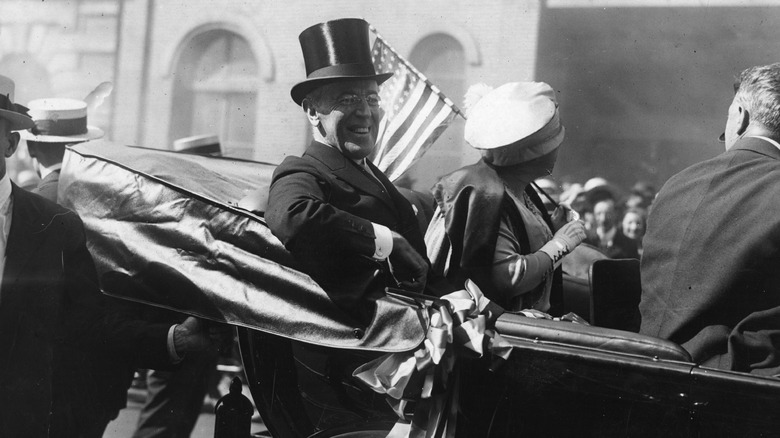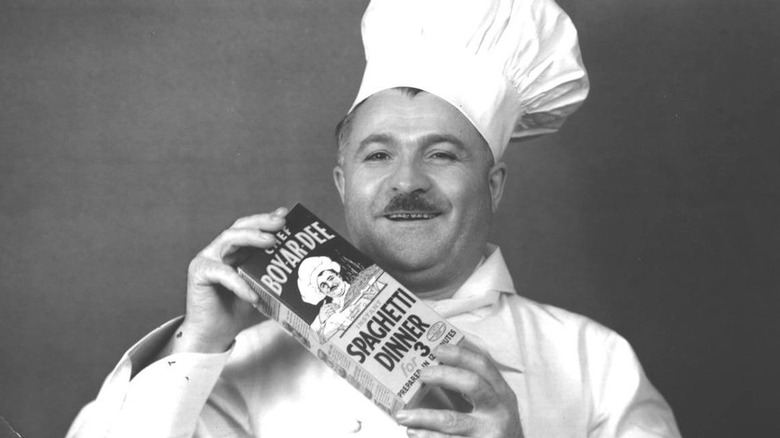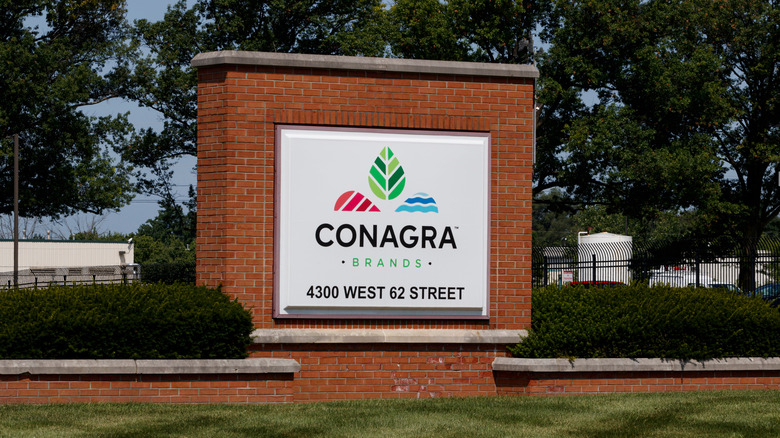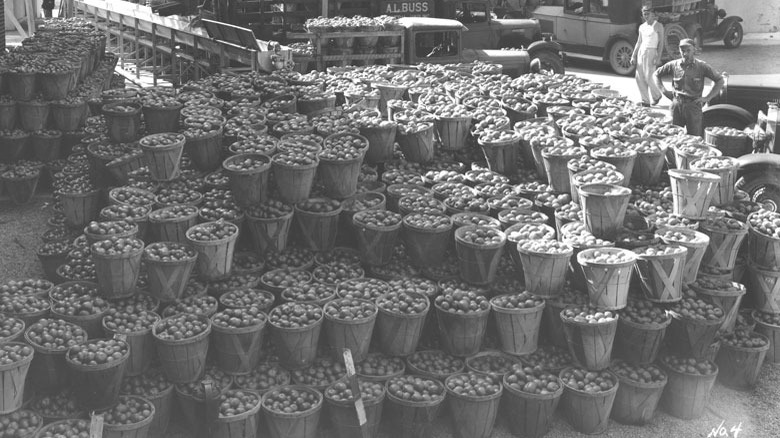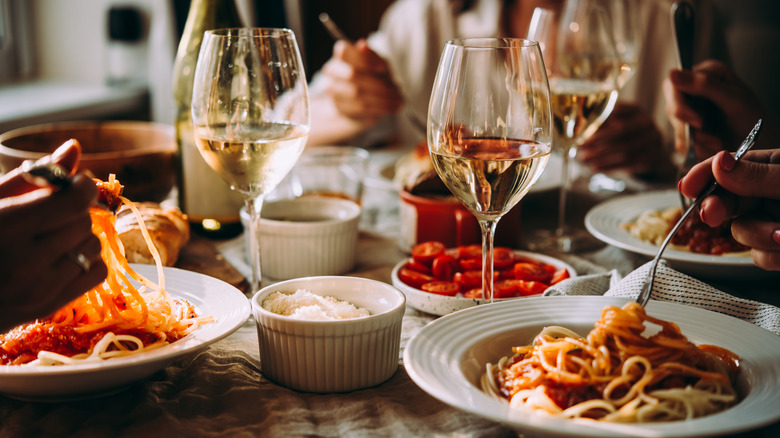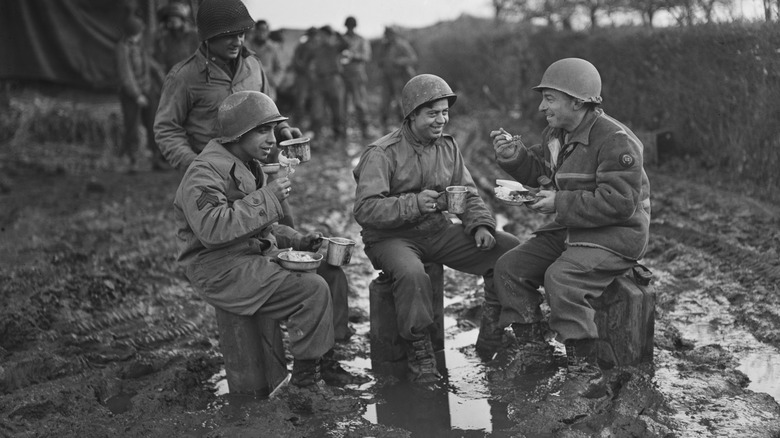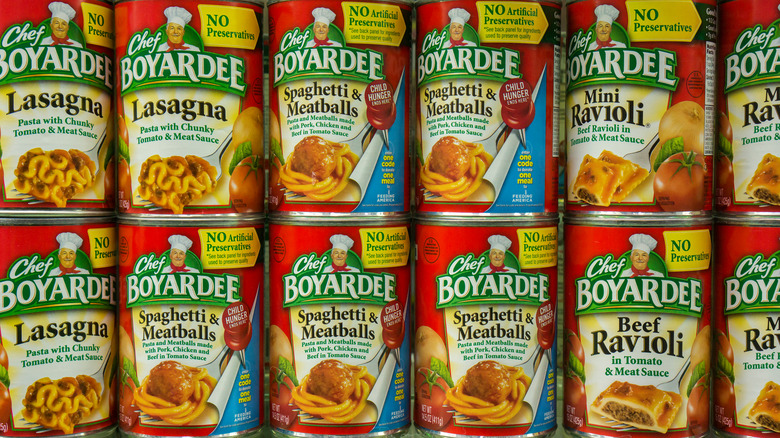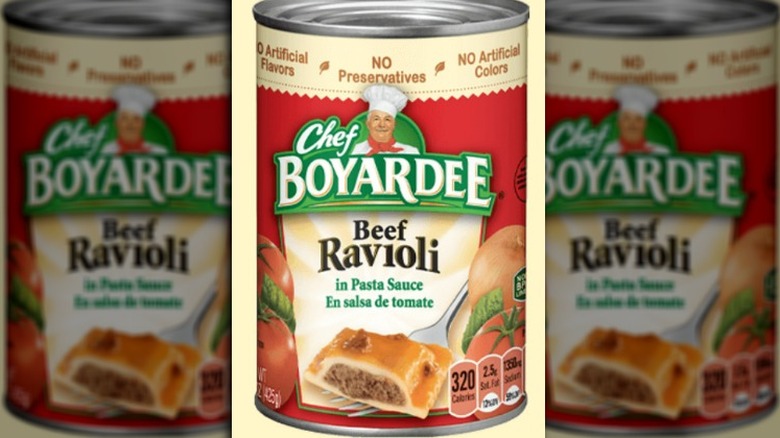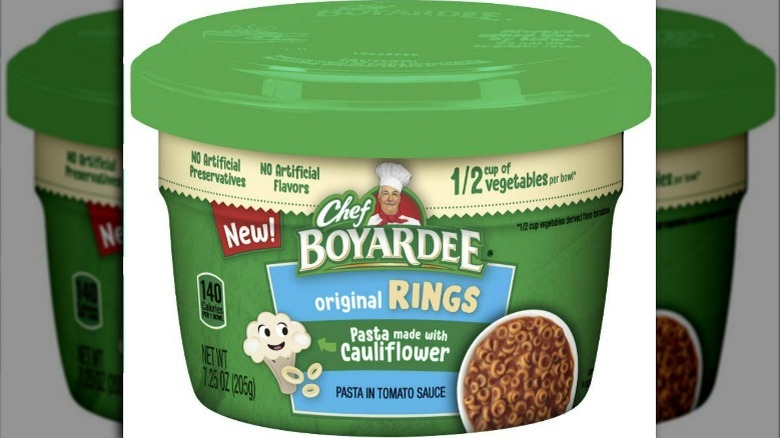Chef Boyardee: 12 Things To Know About The Popular Chef
Remember the simple childhood pleasure of popping open a can of Chef Boyardee for a hearty afternoon snack? Really, this savory treat isn't the exclusive territory of the young. For many adults, Chef Boyardee still figures into their comfort food rotation. And why not? The products are convenient, quick to prepare, and full of umami goodness. But we've got a hunch you get that already, and you're not alone.
Indeed, three million Americans consumed at least five cans of Chef Boyardee's microwaveable entrees and soups in 2020, according to survey data presented by Statista. Another nine million indulged once or twice. If Chef Boyardee products have no place in your life, then it seems you're actually something of an outlier within the U.S. population.
So, what's behind the brand's continuing popularity? It could have something to do with the fact that Chef Boyardee was founded by an actual chef — and a highly acclaimed one at that. Join us as we dig into the longtime brand and the man who made it happen.
1. Chef Boyardee was a real chef
The Chef Boyardee brand was created by a real Italian chef, Ettore Boiardi. Born in 1897 in Northern Italy, Boiardi was 11 when he landed a job apprenticing for a chef at a hotel in his hometown of Piacenza, per the Chef Boyardee website. Soon after, he was training under esteemed chefs in Paris and London. By 1914, he'd immigrated to the U.S. and begun working in the kitchen in New York City's prestigious Plaza Hotel, where his brother Paul had already taken a job as maître d'hôtel (via The New York Times).
Ettore Boiardi's work was so impressive, he was promoted to head chef after just one year. Eventually, he found his way to Ohio, where he became the head chef at Cleveland's Winton Hotel. By 1924, Boiardi had opened his own restaurant, Il Giardino d'Italia, where the seeds of the Chef Boyardee brand were first sown.
2. Chef B may have catered President Woodrow Wilson's second wedding
On December 18, 1915, President Woodrow Wilson married his second wife, Edith Bolling Galt (via History). According to the Chef Boyardee website, Chef Ettore Boiardi, as he was still known at the time, was employed by The Greenbrier Hotel in West Virginia — an elite resort not far from the White House in Washington, D.C. — to supervise the catering for the event.
As the story goes, Boiardi impressed the President and the new First Lady so much that a few years later, they asked him to oversee a dinner they planned for 2,000 soldiers returning from the first World War, according to Weird History Food (via YouTube). While there's no reason not to believe that the young chef did indeed experience these brushes with presidential fame, it's also worth noting that verification as to whether Boyardee actually catered the wedding has proven elusive.
3. The Chef Boyardee brand grew out of this Cleveland Garden
Boiardi met his future wife, Helen Wroblewski, while running the kitchen at Cleveland's Winton Hotel, per Weird History Food (via YouTube). The two wed in 1923 and remained married until Boiardi's death in 1985, as noted by the Los Angeles Times in the chef's obituary. At Helen's urging, Boiardi opened his own restaurant in 1924 in Cleveland — Il Giardino D'Italia. The name translates to "Garden of Italy," and it was in this "Garden" that the Chef Boyardee brand was born.
Boiardi's authentic Italian fare was such a success with customers that there were lines around the block to get a table. In fact, diners loved Boiardi's cooking so much that they began asking him how they might learn to cook Italian cuisine themselves (via NPR). Boiardi accommodated by filling clean milk bottles with his house-made spaghetti sauce for customers to take home.
Soon, Boiardi was selling a make-at-home spaghetti kit complete with his sauce, dried pasta, and grated Parmesan cheese. Demand was so intense that Boiardi hired his brother Mario to help out with production, which eventually moved from the restaurant's premises to a separate processing plant. In 1928, the Chef Boy-Ar-Dee brand was officially born, with Boiardi, Helen, and the chef's two brothers Mario and Paul as partners.
4. From Chef Boiardi, high-end chef, to Chef Boyardee, international brand
By 1928, Boiardi had already adopted an Americanized first name, Hector. When the Chef Boyardee brand was born, Boiardi made another concession — using the surname Boyardee and marketing his new brand under the phonetic spelling, "Boy-Ar-Dee" (via Los Angeles Times). Eventually, the brand dispensed with the hyphens to become what it is today: Chef Boyardee.
In its early days, the company only sold its make-at-home spaghetti kit. It soon branched out, starting with kits featuring one of three sauces — the original tomato, meatless mushroom, and a spicy Neapolitan, per Weird History Food (via YouTube). By 1936, the company had outgrown its Cleveland space, so Boiardi moved operations to Milton, Pennsylvania, per The Standard-Journal. Here, Boiardi enlisted local farmers to grow tomatoes to meet his rising demand and exacting standards.
Business hit the big time when Paul Boiardi managed to get the brand into A&P, the largest grocery store in the U.S. at the time, catapulting Chef Boyardee to national markets, Weird History Food explains. In 1946, American Home Products acquired the company for around $6 million. Boiardi stayed on as a consultant and spokesperson until 1978. In 1996, American Home Products spun off a new company just for its food. The resulting International Home Foods was acquired four years later by its current parent, Conagra.
5. The Chef Boyardee brand transformed the town of Milton, Pennsylvania
When Chef Boyardee moved production to Milton, Pennsylvania, in 1936, the nation was still in the midst of the Great Depression, which began with the stock market crash of 1929 and continued until 1941 (per Federal Reserve History). Boiardi chose Milton because of its richly fertile soil — a boon for growing the ripe, red tomatoes Boiardi wanted to use in his brand's products, according to Chef Boyardee's website. There was also the fact that there were many people in Milton who desperately needed work, per The Standard-Journal.
So, Chef Boyardee worked with the farmers to grow the crops and hired employees among the townspeople to run the company's new production facility. The company even founded a mushroom production facility, the largest of its kind in the U.S. But tomatoes were the star of this show, becoming so central to Milton's economy, that in 1978, the town began putting on the yearly Tomato Harvest Festival, over which Boiardi presided as Master of Ceremonies.
Although Chef Boyardee's tomatoes are now grown in California, the festival remains a cherished annual Milton event to this day. Moreover, Milton remains so indebted to Boiardi's civic contributions that the city honored him by erecting a statue in his honor in 2013, as noted by WNEP.
6. Chef Boiardi is one of the reasons Italian cuisine became popular in the US
Today, you can head to the grocery store and choose from among an ever-growing line of Chef Boyardee products. Indeed, many of us take canned pasta products for granted as being a basic option in the Italian food family, unlike, say, freshly rolled pasta or homemade red sauce. But there was a time when Chef Boyardee's quick and convenient premise was regarded as revolutionary, as JSTOR Daily reports. Moreover, the brand's entry into U.S. supermarkets afforded many Americans their first taste of Italian cuisine, and they wanted more.
"I think it is fair to say that those three men [the Boiardi brothers], with no formal education and very little money, can be credited with bringing Italian food to America," Boiardi's grandniece (Mario's granddaughter), Anna Boiardi, wrote in her 2011 cookbook/memoir, "Delicious Memories: Recipes and Stories from the Chef Boyardee Family." As she pointed out to NPR in an interview contemporaneous with the book's publication, "The new company played a major role in introducing Italian food to the U.S."
Ultimately, the company influenced products Americans were looking for in supermarkets (e.g., olive oil, Italian-style tomatoes, and Parmesan cheese), which helped guide grocers' inventory choices. But no one boosted U.S. importation of authentic Parmesan cheese from Italy quite like Chef Boyardee. At various points in history, the company was the number one importer of the product nationwide.
7. Chef Boyardee's support of the military during WW II was commendable
By the time the U.S. entered World War II in December 1941 (per The National WWII Museum), the Chef Boyardee brand was already well-established and well-loved by millions across the country. So, it's not surprising the U.S. military sought a contract with the company to produce food intended for military personnel (aka Army rations), according to NPR. As the Chef Boyardee website notes, the troops fighting in the war in distant countries were sure to be grateful for these simple "comforts of home."
And so, as the new year dawned, the Milton factory wasn't just producing food for civilians shopping at supermarkets; rather, it was operating 24 hours a day, seven days a week, to meet the demands of both the military and civilians at home. That's not all the Boiardi family and its brand did to raise American spirits. The company employees were equally involved in patriotic marches, carrying banners emblazoned with patriotic slogans like, "Keep 'em flying! Keep 'em rolling! Keep 'em well-fed!" After the war's conclusion, Boiardi was honored with the nation's Gold Star — the highest honor that can be given to a civilian in support of the country's military.
8. The real reason Chef Boiardi sold Chef Boyardee in 1946
As far as Ettore Boiardi's commitment to his employees and to the people of Milton, Pennsylvania, in general, when World War II ended, he was left with a conundrum. During the war, Chef Boyardee was running 24/7 to meet demands, and that meant hiring more people to cover all those extra shifts, according to the company website. Unfortunately, not all of the new hires would be needed to run the business in the aftermath of the war.
Plenty of businesses would simply lay off redundant employees in this situation. Boiardi found another way: He sold the company he'd built from the ground up to a massive corporation, American Home Products. Although he wasn't an owner anymore, he stayed on as a consultant — and very famous spokesperson — until 1978. Even after that, Boiardi's face continued to appear on Chef Boyardee products and still does to this day. The Boiardi family remains proud of its legacy, even if it no longer has direct control over the product, per NPR.
"There is room for all different types of food," Anna Boiardi pointed out to NPR. "My mom is a fabulous cook," she added by way of illustration, but on those nights when time was tight, "she would open up a can of Chef Boyardee for us."
9. The heir apparent to Chef Boyardee didn't follow in his foodie father's footsteps
Chef Boyardee's founder Ettore was passionate about food and cooking from an early age, but his only son, Mario J. Boiardi (1926-2007) didn't exactly follow in his footsteps. Sure, Mario "also loved to cook," as his widow told the Baltimore Sun after his death in 2007. In fact, the couple even met over a mutual appreciation for spaghetti, according to The Star-Democrat. But his passions ultimately lay elsewhere.
The eventual father of five children from two marriages, Mario was born in Cleveland and raised in Milton, right alongside the Chef Boyardee farming and production action. However, rather than attending culinary school, Mario earned an undergraduate degree from Valley Forge Military Academy and College and a business degree from Case Western Reserve University.
Upon returning to Milton after a second military tour in Korea in the early 1950s, Mario became an entrepreneur like his dad — just not in a field connected to food. Rather, he purchased a steel mill with Chef Boiardi and later went solo to establish several other businesses also wholly unrelated to food — a flooring company and a consulting firm. In the 1980s, Mario and his family moved to a 22,000-square-foot estate along Maryland's Wye River, before ultimately retiring to nearby Queenstown.
10. Chef Boyardee was hit with a false advertising lawsuit
In 2015, Chef Boyardee and its parent company Conagra Foods were hit with a class action lawsuit accusing them of false advertising in violation of the Federal Food, Drug and Cosmetic Act, Top Class Actions reported. The premise was that while every Chef Boyardee product label promised contents free from preservatives, many actually contained citric acid, which is in fact, a preservative. The class action complaint sought $5 million in damages to be shared by those who had purchased Chef Boyardee products in the previous three years.
In 2016, the suit was dismissed without prejudice — but not on the suit's merits. Rather, the plaintiff had failed to properly serve the defendant companies, according to Truth in Advertising. A dismissal without prejudice of this kind entitles the plaintiff to refile the complaint with proper service. However, that does not appear to have occurred.
Today, Chef Boyardee boasts a number of pasta products containing "no artificial flavors, colors, or preservatives," per the company website. These include beef ravioli, spaghetti & meatballs, Beefaroni, mini ravioli, lasagna, overstuffed beef ravioli, jumbo spaghetti & meatballs, overstuffed Italian sausage ravioli, and cheese ravioli, according to the labeling on the cans. The company does, however, continue to use citric acid as an ingredient.
11. Chef Boyardee offers some health-conscious options
Comfort food isn't necessarily synonymous with healthy options, but Chef Boyardee has been making an effort as of late. To wit, in 2020, Instagrammer, @DadBodSnacks revealed that Chef Boyardee had just come out with its first pasta made using cauliflower. Apparently, however, this is not a gluten-free pasta because the pasta also contains wheat, as confirmed by a quick glance at the label. In other words, it consists of pasta with added cauliflower, as opposed to grain-free cauliflower pasta.
What Chef Boyardee's cauliflower pasta products do offer to consumers is an opportunity to sneak some veggies past their unsuspecting kiddies, which is a perfectly acceptable practice, as registered dietitian, Toby Amidor, M.S. tells Food Network. Amidor suggests offering kids veggies with their meals as soon as they're old enough to chew them, in an effort to get them used to eating veggies from the start. Although it's preferable to introduce vegetables to children in their unadulterated natural state, it's worth pointing out that sometimes stealth vegetable delivery may be a parent's best bet for making sure their kiddos are getting enough of the good stuff.
12. His grand-niece published a cookbook with family favorites
As noted above, Ettore Boiardi wasn't the only family member involved with the company — he recruited his brothers into the business too, and his wife was also a partner. As it turned out, one of the brothers, Mario, had a granddaughter who shares Boiardi's love for cooking up authentic Italian cuisine. You can find recipes along those lines in Anna Boiardi's 2011 cookbook slash memoir, "Delicious Memories: Recipes and Stories from the Chef Boyardee Family."
"I am hoping that people learn these traditional recipes and it helps to preserve them," Boiardi told Bon Appétit at the time of the book's publication. Still, as previously noted, Boiardi and her extended family are proud of the Chef Boyardee legacy created by her great uncle Ettore — even if canned pasta doesn't actually exist, per se, in Italy. And in case you had any doubts, consider that the book includes Chef Boiardi's cherished recipe for the original spaghetti sauce that started it all.
